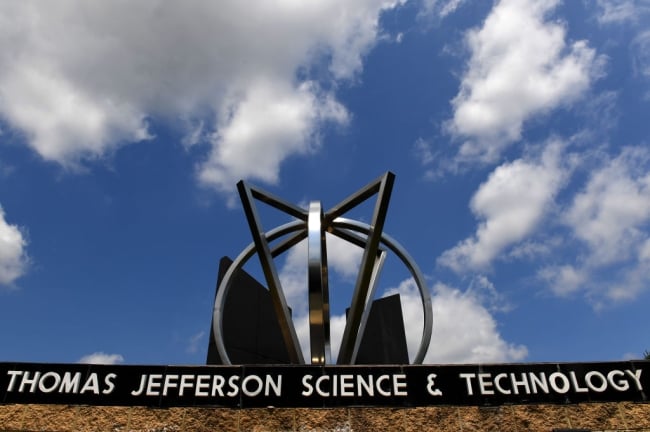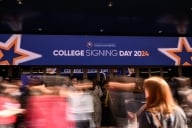You have /5 articles left.
Sign up for a free account or log in.

The Supreme Court declined to hear a case against diversity-focused admissions policies at Thomas Jefferson High School for Science and Technology, in a decision with implications for higher ed.
Katherine Frey/The Washington Post/Getty Images
The U.S. Supreme Court declined to intervene Tuesday in a closely watched case concerning admissions policies meant to increase racial diversity at an elite Virginia magnet high school, potentially green-lighting a set of “race-neutral” admission practices for higher ed institutions seeking to counteract the court’s affirmative action ban handed down last summer.
The case was brought by Asian American families against Thomas Jefferson High School for Science and Technology, a highly competitive public magnet school in Alexandria, Va. The plaintiffs argued that policies the school implemented to increase the number of Black and Latino students following the 2020 murder of George Floyd amounted to discrimination against their children.
A Fourth Circuit appeals court decided in a split ruling last May that the practices did not constitute discrimination against white and Asian students; the Supreme Court’s denial lets that decision stand.
The majority gave no written explanation of their decision to decline, as is customary. Justice Samuel Alito, joined by Justice Clarence Thomas, issued a scathing 10-page dissent calling the Fourth Circuit’s ruling “indefensible,” and saying the court’s decision to let it stand was “hard to understand.”
Glenn Roper, a senior attorney for the Pacific Legal Foundation, which represented the plaintiffs, said his clients were “devastated” by the court’s decision but that the foundation—a conservative legal nonprofit that has several similar cases pending in the high court’s docket—is undeterred.
“If anything, this multiplies our efforts,” he told Inside Higher Ed. “There are multiple unanswered questions from the Students for Fair Admissions ruling that the court is going to have to address eventually.”
The Supreme Court has not taken up multiple opportunities to address questions lingering from the vague and at times self-contradictory June ruling, which left many colleges scrambling for legal alternatives to maintain diversity in admissions. Earlier this month the justices declined to issue an emergency injunction against the U.S. Military Academy West Point over its continued use of race-conscious admissions, an exemption that Chief Justice John Roberts alluded to but did not cement in his majority opinion last June.
A Victory for ‘Race-Neutral’ Diversity Efforts?
Among the strategies Thomas Jefferson implemented were priority admission for the top 1.5 percent of eighth graders in the county’s public middle schools, a waiver of the traditional $100 admission fee and the elimination of a rigorous entrance exam—changes that mirror some colleges’ proposals for post–affirmative action diversity efforts, like top 10 percent plans and test-optional policies. Admissions officers at Thomas Jefferson were also instructed to consider “experience factors” such as family income, first-generation status and membership in any historically underrepresented groups.
Richard Kahlenberg, a lecturer at George Washington University’s school of public policy and a longtime advocate for class-based affirmative action, called the decision to pass on the Thomas Jefferson case “very good news” for advocates of race-neutral diversity efforts.
“Typically if SCOTUS is upset about the direction of the lower courts, they don’t hesitate to intervene. That they didn’t is, to me, a green light for authentic, race-neutral strategies to increase diversity,” he said. “I think the court is hitting a sweet spot that aligns with most Americans’ thinking: that the goal of racial diversity is commendable, but racial preferences are not.”
Roper said that while he hesitates to conjecture about the justices’ rationale, he believes the Thomas Jefferson case was a clear example of racially discriminatory practices disguised as diversity efforts. He worries that the Supreme Court’s refusal to review it will encourage other competitive high schools—as well as colleges—to adopt similar practices.
“They say it’s not discriminatory but the proof is in the results. They admit that it had a racial purpose,” he said. “The Fourth Circuit essentially blessed discrimination as long as it doesn’t go too far. Letting that decision stand is just going to make things messy for other institutions.”
Sonja Starr, a law professor at the University of Chicago, cautioned against reading too much into the denial. She said it could be a sign that a majority of justices do not share some of the more radical interpretations of the SFFA decision—that it prohibits institutions from taking any actions for the purpose of increasing racial diversity, for instance. Or it could just mean this isn’t the right case, or the right time, to clarify the ruling.
“They’re letting the issue percolate among the lower courts,” she said. “The Supreme Court will have plenty more opportunities to take a bite from this particular apple, but it’s clear that the court is not chomping at the bit to resolve this right away.”
Waiting for the Other Shoe to Drop
Kahlenberg doesn’t believe the SFFA decision was the Supreme Court’s “last word” on affirmative action. He suspects there will be plenty more scrutiny when the demographics of next year’s admitted college class become public in a few months—especially if the selective institutions that once used affirmative action maintain or increase their shares of underrepresented minorities.
“I think the court is likely to weigh in vigorously if there’s evidence that colleges are ignoring the [SFFA] decision, and I think this next incoming class might raise some red flags,” he said.
Starr isn’t sure it will be so simple.
“My view is that acceptance numbers alone are not going to be enough to build a case,” she said. “I suspect law firms will start filing cases then, but they’re going to have an evidentiary burden to prove that institutions are essentially doing affirmative action in disguise.”
Kahlenberg said he thinks colleges will get into trouble if they use applicants’ personal essays to circumvent the ban on race-conscious admissions—a strategy that colleges appear to have toyed with in the initial aftermath of the ruling, though Roberts explicitly forbade such “proxies” for affirmative action in his SFFA majority opinion.
“There are two paths colleges now have to pursue racial diversity: race-neutral or economically focused policies, like those Thomas Jefferson High School had, and using the college essay,” Kahlenberg said. “The latter is where there’s a real danger of institutions pursuing loopholes. I think many colleges may end up essentially cheating, and that’s where the court is likely to crack down.”
Starr said that might happen, but collecting enough evidence to prove it is a tall and time-consuming order.
“It may take some years for lawsuits to develop that are credible enough to get the Supreme Court’s attention again,” she said. “People saw the [SFFA] affirmative action decision coming down the pike for a decade before they finally decided. These things take time.”









